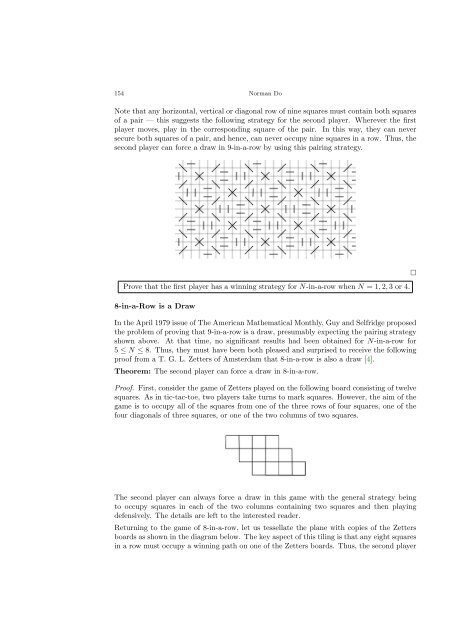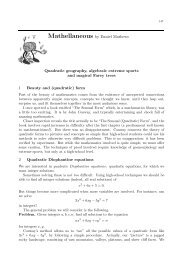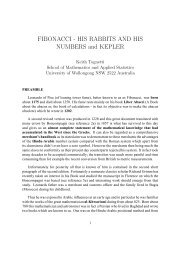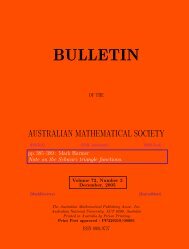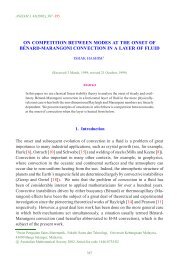Gazette 31 Vol 3 - Australian Mathematical Society
Gazette 31 Vol 3 - Australian Mathematical Society
Gazette 31 Vol 3 - Australian Mathematical Society
You also want an ePaper? Increase the reach of your titles
YUMPU automatically turns print PDFs into web optimized ePapers that Google loves.
154 Norman Do<br />
Note that any horizontal, vertical or diagonal row of nine squares must contain both squares<br />
of a pair — this suggests the following strategy for the second player. Wherever the first<br />
player moves, play in the corresponding square of the pair. In this way, they can never<br />
secure both squares of a pair, and hence, can never occupy nine squares in a row. Thus, the<br />
second player can force a draw in 9-in-a-row by using this pairing strategy.<br />
Prove that the first player has a winning strategy for N-in-a-row when N = 1, 2, 3 or 4.<br />
8-in-a-Row is a Draw<br />
In the April 1979 issue of The American <strong>Mathematical</strong> Monthly, Guy and Selfridge proposed<br />
the problem of proving that 9-in-a-row is a draw, presumably expecting the pairing strategy<br />
shown above. At that time, no significant results had been obtained for N-in-a-row for<br />
5 ≤ N ≤ 8. Thus, they must have been both pleased and surprised to receive the following<br />
proof from a T. G. L. Zetters of Amsterdam that 8-in-a-row is also a draw [4].<br />
Theorem: The second player can force a draw in 8-in-a-row.<br />
Proof. First, consider the game of Zetters played on the following board consisting of twelve<br />
squares. As in tic-tac-toe, two players take turns to mark squares. However, the aim of the<br />
game is to occupy all of the squares from one of the three rows of four squares, one of the<br />
four diagonals of three squares, or one of the two columns of two squares.<br />
The second player can always force a draw in this game with the general strategy being<br />
to occupy squares in each of the two columns containing two squares and then playing<br />
defensively. The details are left to the interested reader.<br />
Returning to the game of 8-in-a-row, let us tessellate the plane with copies of the Zetters<br />
boards as shown in the diagram below. The key aspect of this tiling is that any eight squares<br />
in a row must occupy a winning path on one of the Zetters boards. Thus, the second player<br />
�


